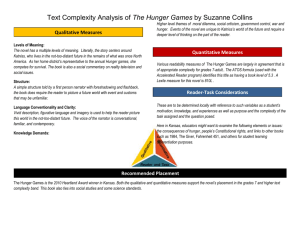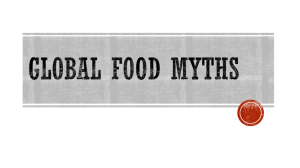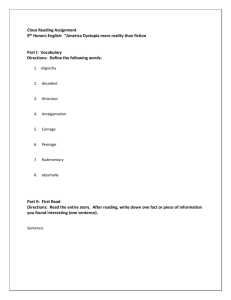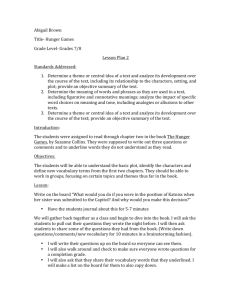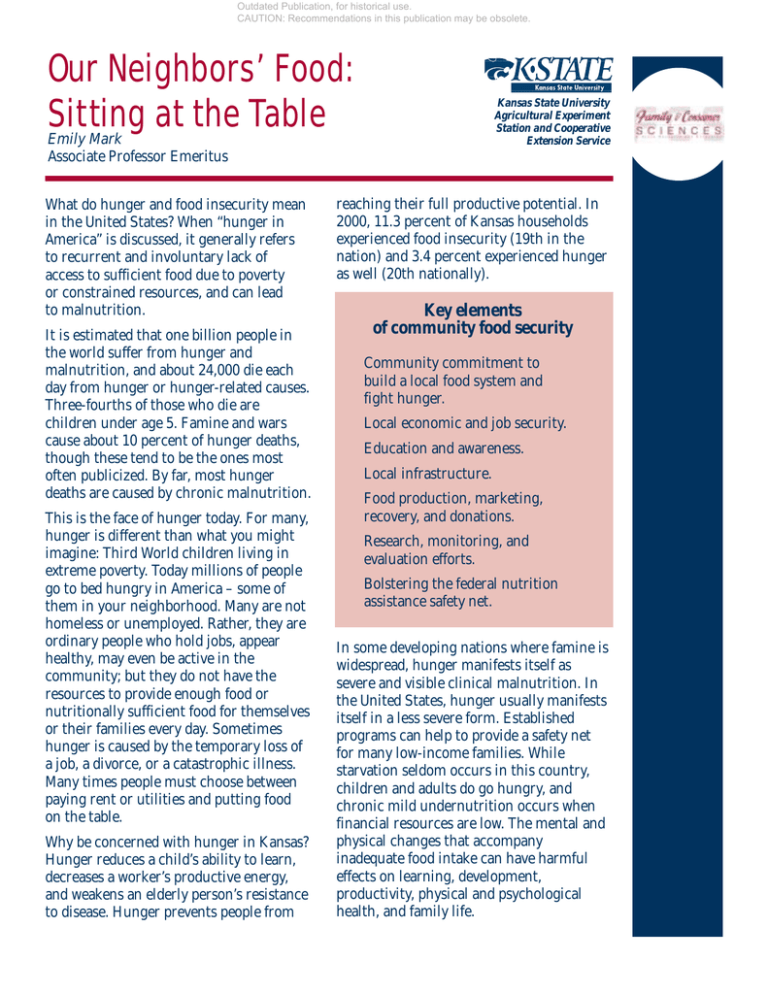
Outdated Publication, for historical use.
CAUTION: Recommendations in this publication may be obsolete.
Our Neighbors’ Food:
Sitting at the Table
Kansas State University
Agricultural Experiment
Station and Cooperative
Extension Service
Emily Mark
Associate Professor Emeritus
What do hunger and food insecurity mean
in the United States? When “hunger in
America” is discussed, it generally refers
to recurrent and involuntary lack of
access to sufficient food due to poverty
or constrained resources, and can lead
to malnutrition.
It is estimated that one billion people in
the world suffer from hunger and
malnutrition, and about 24,000 die each
day from hunger or hunger-related causes.
Three-fourths of those who die are
children under age 5. Famine and wars
cause about 10 percent of hunger deaths,
though these tend to be the ones most
often publicized. By far, most hunger
deaths are caused by chronic malnutrition.
This is the face of hunger today. For many,
hunger is different than what you might
imagine: Third World children living in
extreme poverty. Today millions of people
go to bed hungry in America – some of
them in your neighborhood. Many are not
homeless or unemployed. Rather, they are
ordinary people who hold jobs, appear
healthy, may even be active in the
community; but they do not have the
resources to provide enough food or
nutritionally sufficient food for themselves
or their families every day. Sometimes
hunger is caused by the temporary loss of
a job, a divorce, or a catastrophic illness.
Many times people must choose between
paying rent or utilities and putting food
on the table.
Why be concerned with hunger in Kansas?
Hunger reduces a child’s ability to learn,
decreases a worker’s productive energy,
and weakens an elderly person’s resistance
to disease. Hunger prevents people from
reaching their full productive potential. In
2000, 11.3 percent of Kansas households
experienced food insecurity (19th in the
nation) and 3.4 percent experienced hunger
as well (20th nationally).
Key elements
of community food security
Community commitment to
build a local food system and
fight hunger.
Local economic and job security.
Education and awareness.
Local infrastructure.
Food production, marketing,
recovery, and donations.
Research, monitoring, and
evaluation efforts.
Bolstering the federal nutrition
assistance safety net.
In some developing nations where famine is
widespread, hunger manifests itself as
severe and visible clinical malnutrition. In
the United States, hunger usually manifests
itself in a less severe form. Established
programs can help to provide a safety net
for many low-income families. While
starvation seldom occurs in this country,
children and adults do go hungry, and
chronic mild undernutrition occurs when
financial resources are low. The mental and
physical changes that accompany
inadequate food intake can have harmful
effects on learning, development,
productivity, physical and psychological
health, and family life.
Outdated Publication, for historical use.
CAUTION: Recommendations in this publication may be obsolete.
Food for thought
Over the last two decades new terms have
evolved to describe the widespread, but
less severe, hunger problems typically
encountered in the United States.
“Food security” is a term used to describe
what our nation seeks for its people –
assured access at all times to enough safe
food for an active, healthy life without
dependence on emergency sources to
meet basic food needs. In a nation as
affluent as ours, this goal is readily
achievable. “Food insecurity” refers to
the lack of access to enough food to fully
meet basic needs at all times. There are
different levels of food insecurity.
Since 1995 the U.S. Census Bureau has
conducted an annual survey of food
security among a nationally representative
sample, using the food security module in
the Current Population Survey (CPS). The
questions deal with anxiety that the
household budget is inadequate to buy
enough food, inadequacy in quantity or
quality of food eaten by adults and
children in the household, and instances
of reduced food intake or consequences of
reduced food intake for adults and for
children. Households are classified as
“food secure,” “food insecure,” or “food
insecure with hunger.”
The survey is widely regarded as a reliable
indicator of household well-being and
serves as the basis in evaluating progress
toward reducing food insecurity – one of
the U.S. Surgeon General’s health
objectives for the nation by the year 2010.
The goal is to increase food security from
88 percent of all U.S. households (1995)
to 94 percent.
Households classified as hungry are those
in which adults have decreased the quality
and quantity of food consumption to the
point they are likely to be hungry, or in
which children’s intake has been reduced
to the point they are likely to be hungry
and adult food intake is severely reduced.
2
Even when hunger is not present, adults in
households classified as “food insecure” have
such limited resources that they may run out
of food, reduce equality of food in the family,
feed their children unbalanced diets, or skip
meals so their children can eat.
According to the results of the Census
Bureau survey, those at greatest risk of
food insecurity live in households headed
by a single woman, are Latino or AfricanAmerican, or have incomes below the
poverty line. Overall, households with
children experience food insecurity at
more than double the rate for households
without children.
Other evidence that many people are hungry
in America comes from the widespread
reports of increases in the number of
households seeking emergency food at
feeding programs, food pantries, and soup
kitchens. A high number of food insecure
households in a nation with our economic
plenty means the fruits of our economy, and
the benefits of public and private programs
for needy people, are not yet reaching
millions of low-income people who are at
great risk.
Poverty and food insecurity rates are
closely linked. In Kansas, the
unemployment rate rose from 3.9
percent in 2000 to 5.2 percent in
2003. The state ranks 12th for
children living in poverty: more than
1 in 10. Kansas food stamp use is
below the national average for food
insecure households: Only about 50
percent of those eligible use food
stamps. Households rated as food
insecure make up 11.3 percent of
those in the state, and 3.4 percent are
food insecure with hunger also noted.
Source: Household Food Security
in the United States
Outdated Publication, for historical use.
CAUTION: Recommendations in this publication may be obsolete.
Hunger facts
• A 2002 survey of emergency food
assistance providers found that more
than half of food bank and food rescue
organizations reported facing needs they
could not meet.
• Nearly two-thirds of adult emergency
food recipients are women, and more
than one in five are elderly.
• Some 20 to 30 million Americans have
inadequate resources to meet their
monthly expenses and buy enough food
to live healthy lives.
• One of six elderly people in the United
States has an inadequate diet.
• Young people are more likely to live in
poverty than any other age group, and
the disparity is growing.
• One of four American children under
age 6 lives in poverty.
• In the United States 64 percent of
children under age 6 in female-headed
single parent families live in poverty.
• Children make up almost one-third of
the population living below the federal
poverty line.
• Children who experience food
insecurity and hunger are more likely
to show behavioral, emotional, and
academic problems than children from
low-income families who do not report
experiences of food insecurity.
• Consequences of hunger in children
include infant mortality, anemia, and
poor learning as well as frequent colds,
ear infections, asthma, headaches, and
stomachaches.
• Nearly 12 percent of the U.S. population
lives below the federal poverty level.
• The federal poverty level is about
$18,400 for a family of four, but families
earning twice that much can experience
food insecurity.
• Each year, America has two million
homeless people.
• In Kansas 303,000 people experience
food insecurity.
• More Spanish-speaking individuals
than English speakers experience
food insecurity.
• Single females experience greater food
insecurity in their households than their
married counterparts.
• In Kansas, 40,000 of the 97,000
people who have experienced hunger
are children.
• The Food Stamp program is the
mainstay of the national nutrition
safety net.
• Each month, 140,000 Kansans receive
food stamps.
• The average monthly Food Stamp benefit
per person is $67.23 (FY 2002).
• Kansas ranks 47th in the percentage
of low-income children who participate
in summer feeding programs, and only
7 percent of children who are eligible
are served.
• Kansas ranks 15th in the percentage of
low-income children participating in school
breakfast, with only 48 percent of those
eligible served.
3
Outdated Publication, for historical use.
CAUTION: Recommendations in this publication may be obsolete.
Low-cost meal
Red beans and rice supply the body with
an excellent source of protein at a minimum cost. Consider serving a meal of
Red Beans and Rice to your family. The
Red Beans and Rice
6 portions
2
⁄3 cup celery, chopped
2
⁄3 cup onions, chopped
3
⁄4 cup green pepper, chopped
2 cans (1 lb. each) red beans,
undrained
1 bay leaf
1
⁄2 teaspoon ground white pepper
1
⁄4 teaspoon dry thyme leaves
1
⁄2 teaspoon garlic powder
1
⁄2 teaspoon dry oregano leaves
1
⁄4 teaspoon ground red pepper
1
⁄8 teaspoon ground black pepper
1 teaspoon hot sauce
2
⁄3 teaspoon bottled smoke flavoring
2
⁄3 cup water
3 cups cooked rice
(for 1⁄2 cup servings)
savings can be used to make a contribution
to help fight hunger locally.
The recipe also could be served at a community or organizational event.
Spray large saucepan with cooking
spray or lightly coat bottom with
vegetable oil. Place prepared vegetables
in pan and cook over low heat until
softened. Add beans to cooked
vegetables. Add seasonings and water.
Bring to a boil, cover, reduce heat and
simmer 2 to 3 hours, stirring often.
Cook to end point temperature of 180
to 190°F. Beans should be spicy and
slightly hot, with a faint taste of
smoke. Sauce should be the consistency of gravy.
Serve beans over rice.
Nutrition per serving
Calories:
238
Protein:
13g
Carbohydrates: 54g
Dietary fiber:
15g
Calories from fat: 3%
To those who have hunger, give bread.
To those who have bread, give a hunger for justice.
– Latin American Table Prayer
Brand names appearing in this publication are for product identification purposes only.
No endorsement is intended, nor is criticism implied of similar products not mentioned.
Publications from Kansas State University are available on the World Wide Web at: www.oznet.ksu.edu
Publications from Kansas State University may be freely reproduced for educational purposes. All other rights reserved.
In either case, credit Emily Mark, Our Neighbors’ Food: Sitting at the Table - Fact Sheet, September 2003.
Kansas State University Agricultural Experiment Station and Cooperative Extension Service , Manhattan, Kansas
MF-2591
SEPTEMBER 2003
It is the policy of Kansas State University Agricultural Experiment Station and Cooperative Extension Service that all persons shall have equal opportunity and access to its
educational programs, services, activities, and materials without regard to race, color, religion, national origin, sex, age, or disability. Kansas State University is an equal
opportunity organization. These materials may be available in alternative formats.
Issued in furtherance of Cooperative Extension Work, Acts of May 8 and June 30, 1914, as amended. Kansas State University, County Extension Councils, Extension Districts,
and United States Department of Agriculture Cooperating, Marc A. Johnson, Director.
4


